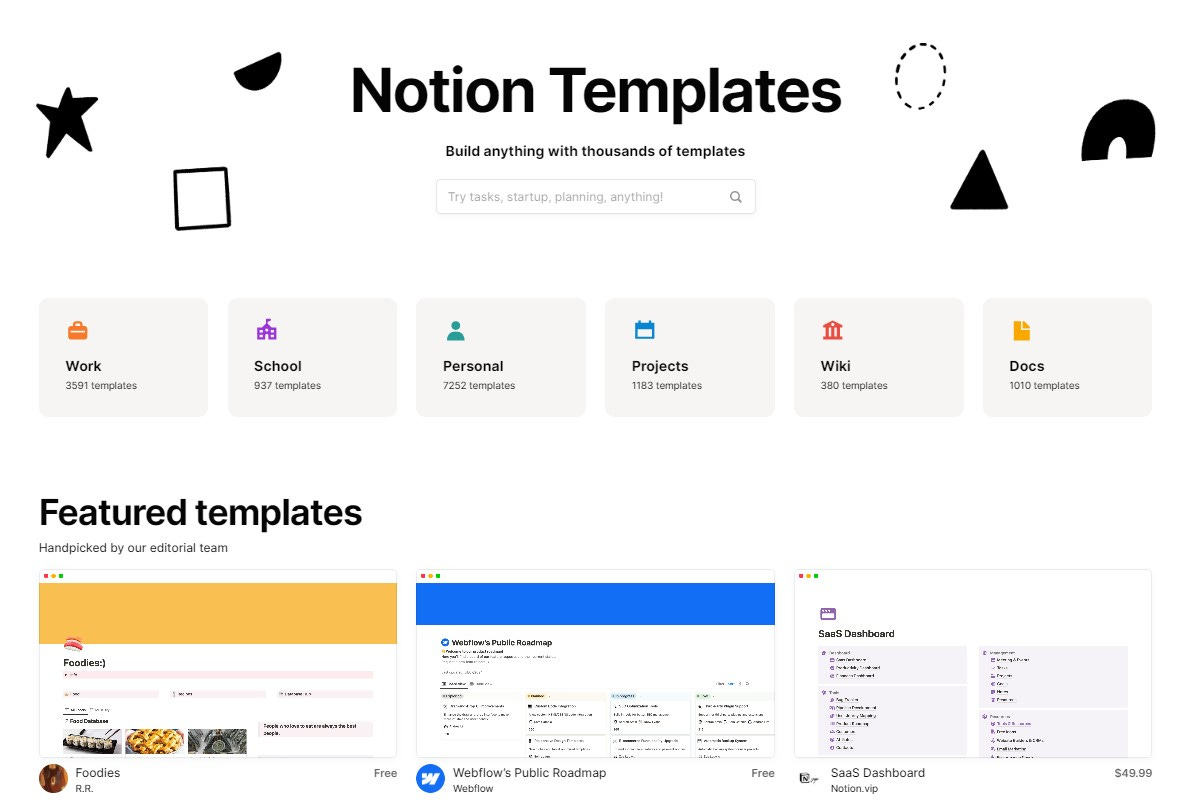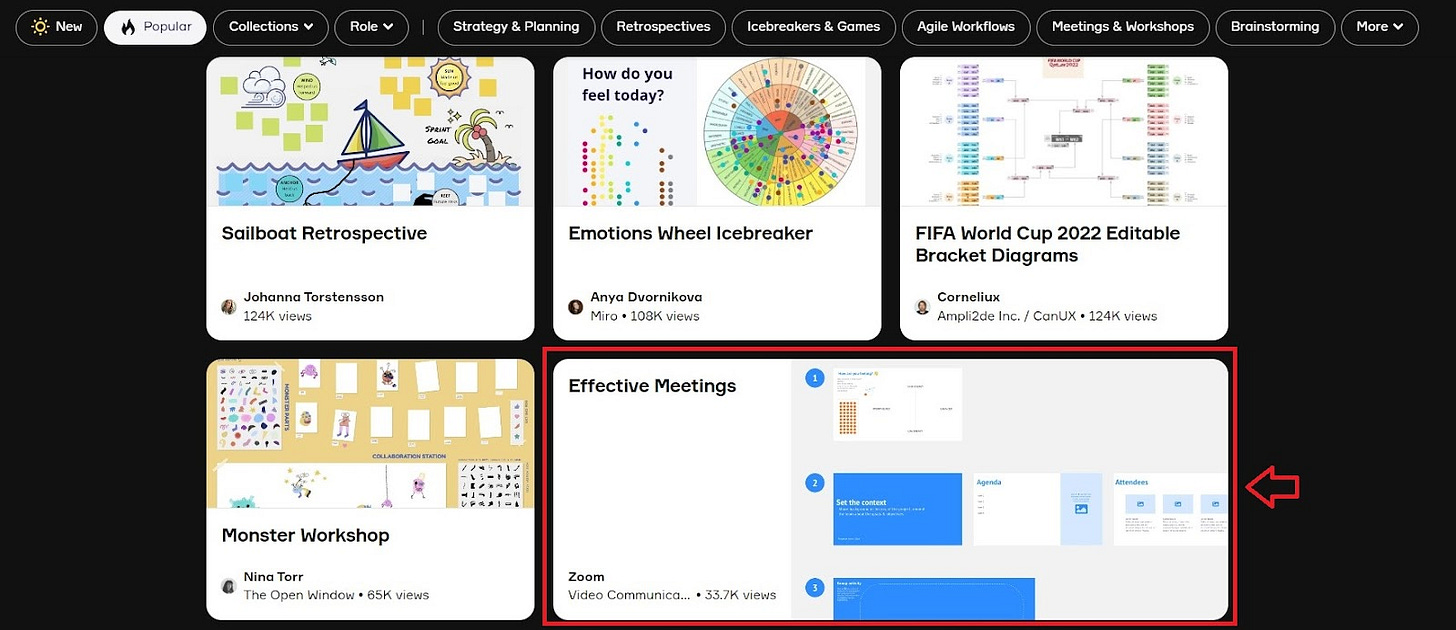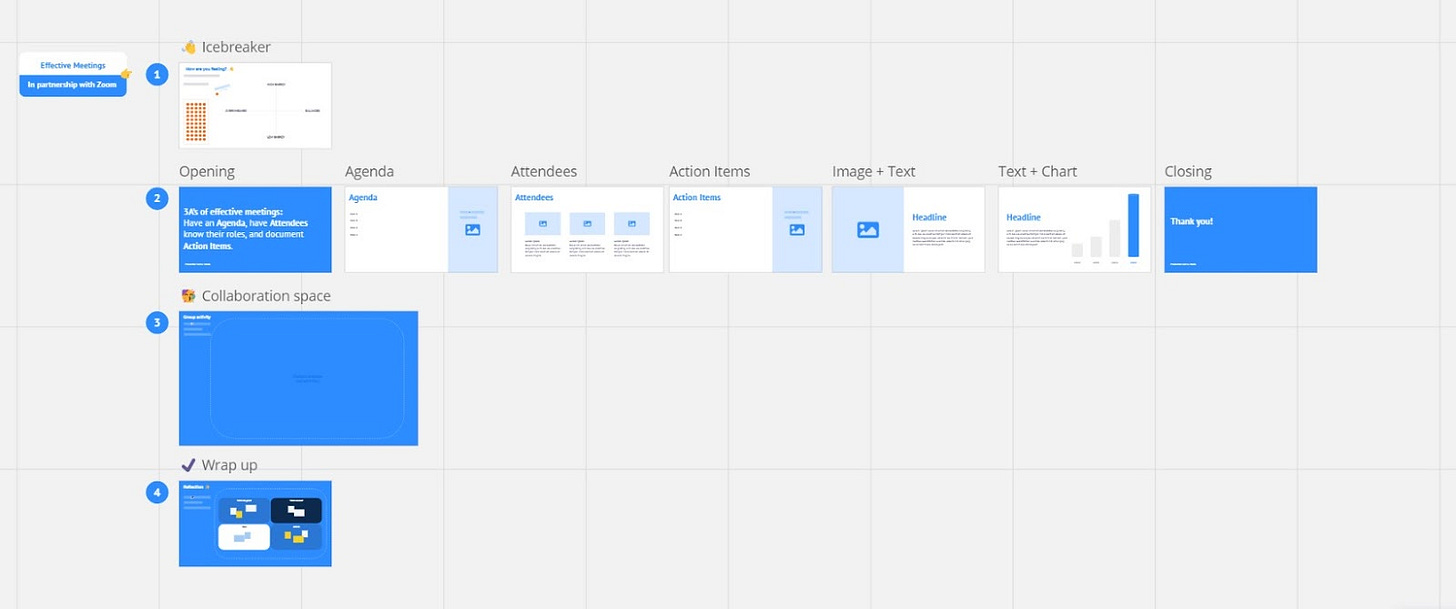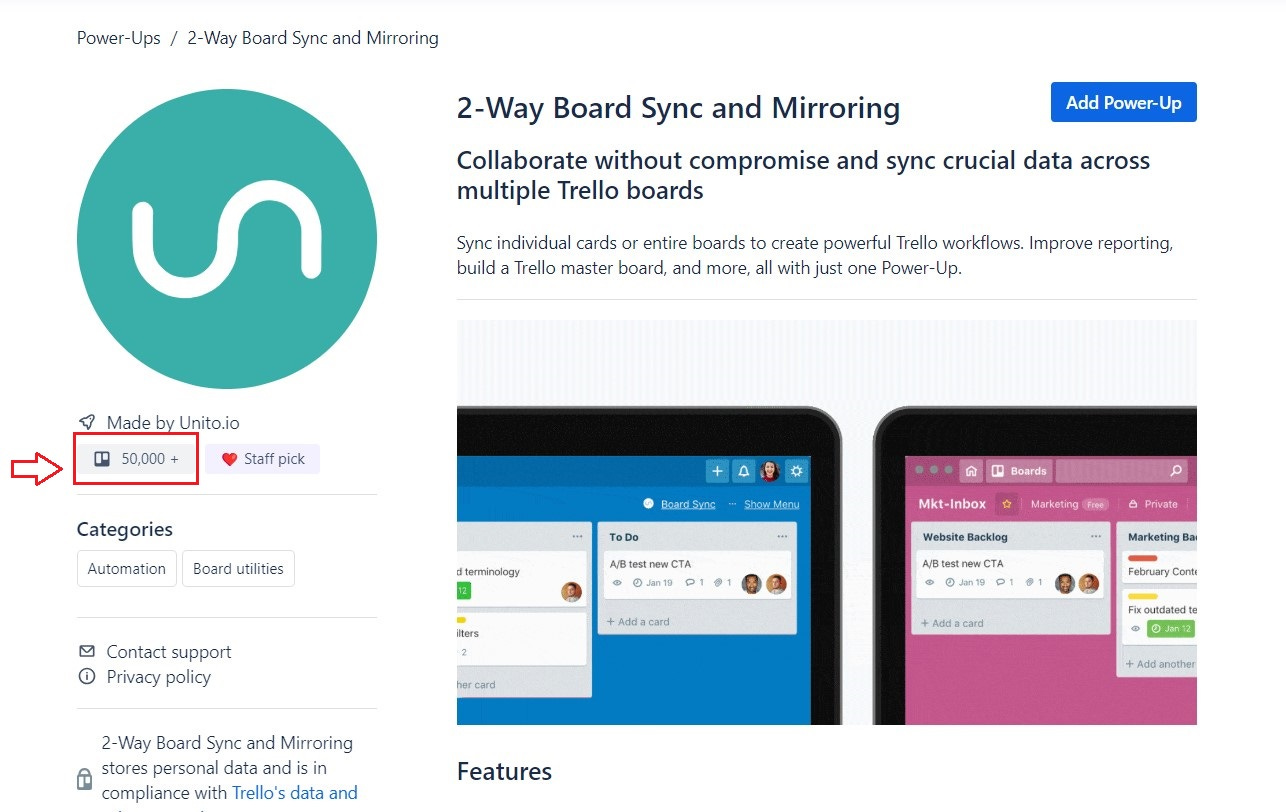A new distribution channel
A new way to distribute and monetize content—template marketplaces
👋 Hey, I’m George Chasiotis. Welcome to GrowthWaves, your weekly dose of B2B growth insights—featuring powerful case studies, emerging trends, and unconventional strategies you won’t find anywhere else.
Recently, I was searching for a podcast template checklist.
Out came a page on Notion with a paid template as the top result.
“Interesting,” I thought, “Let me take a look at it.”
Before I knew it, I was down the rabbit hole of templates created by thousands of contributors, both individuals and brands.
And although their templates were on different topics, there was one thing that united them.
They all used Notion to share content.
Not only that, but many of them also monetized their content through it.
What is this other than a new distribution channel?
And, turns out, Notion wasn’t the only example out there.
As I was digging deeper, I discovered many other similar opportunities, where creators and brands submitted their content for further use.
But is it a viable option for B2B companies?
Let’s find out.
Key findings
Let me first sum up the key findings from my research:
Content distribution platforms aren’t just for small creators—Zoom’s template on Miroverse (another template platform, which I discuss below) reached 33.7K views, proving that businesses of any size can do well in these spaces.
Sharing templates on the platform relevant to your niche can help drive more leads. Distributing templates through Trello, which Unito (see below) integrates with, helped Unito get 50,000 Trello board users.
Before distributing content through platforms like Notion, Trello, or Miro, in-depth research into these spaces is crucial, as it ensures you create and share exactly what’s in demand.
Following the above step helped Unito’s templates reach 10,630 copies and 91,500 views.
Choose the platform with your target audience in mind. Rich behind Template Road (another success story that I will come back to) chose Notion because it allows for easier distribution of the templates.
Monetization is a good option if you think this will attract the right customers—it worked well for Rich.
Overall, the benefit of this type of distribution channel is threefold: getting visibility through search, getting visibility through the platform itself, and monetizing your content.
Intrigued?
Let’s dive in!
Notion Templates
Notion has a dedicated section on its website called Templates, where Notion and (mostly) other contributors upload templates on different topics.

What’s the purpose of it?
I’d say it’s twofold:
All template creators automatically become Notion users.
Notion uses this channel as a means of adding more value to its user and customer base.
So, it’s essentially a big catalog of checklists, planners, and other template types for any need; some free, some paid.
All templates are neatly categorized and broken down into featured templates, top categories, featured creators, and featured collections.
Altogether, there are:
What’s most notable is that 4,629 contributors (as of January 16th, 2024) have already taken the opportunity to distribute their content through Notion.
Not only does it help them gain extra visibility but they also get to monetize their creations.
Besides, by distributing content through Notion’s template section, you get visibility through Notion’s website (i.e., from its users and customers) and organic search, as Notion has prominent visibility in Google.
Now, let’s take a look at a contributor on Notion and analyze whether this distribution channel is, in fact, as effective as I assumed.
Example: Template Road
Recently, I’ve been searching for podcast checklist templates and came across a Notion user called Template Road.
He had exactly what I was looking for—a straightforward and detailed checklist with everything one needs to launch a podcast.
The template costs $7 and looks like this:

While browsing the page with the template, I noticed that this user already had 114 templates on his profile.
And, what’s more, he was doing it professionally—developing templates and monetizing them.
In fact, most templates on his page were paid.
The average price for a template is $4–$5.
Further investigation showed that the person behind this account, Rich Peterson, already had a website called Template Road.
According to this site, Template Road creates Notion templates that “bring you closer to being a planning expert in your office.”
Most templates fall under the categories of event planning, marketing, and operations.
And, what’s most notable, many famous brands and establishments are already using Rich’s templates—Sage, Yale University, UCLA, FedEx, and many others.
This must be a great income source for this guy, I thought.
So, I decided to reach out to him and ask a few questions about how he made this content distribution channel work so well for him.
Rich is a workflow coach from Australia, helping companies audit their operations, grow, and improve.
Aside from Template Road, he initiated a space called Template School.
“I’ve been slowly building Template School to help people build templates across multiple platforms,” he explained.
Template School includes over 1 million template ideas and teaches people how to monetize their creations.
So, indeed, Rich managed to build an entire business around templates.
I was curious about how he came up with this idea in the first place.
Here’s what he shared.
“In the past, I had worked in financial services creating financial plans for customers. From doing this work, I realized that I could create templates to speed up my process. I would quote for a fixed amount of hours and then create templates to speed up the process so my effective hourly rate increased. Fast forward a few years, and I was doing business coaching/service design for clients and wanted to share my frameworks for how to run a business through templates.”
Given the success of his creations, he decided to start sharing them through Notion, which he chose for its simplicity.
“[Notion] feels like pages are a Word doc with an Excel table thrown in. Notion templates are also really simple to share and duplicate, so you can share a link, and someone can click a button to add to their account without needing to download and then upload.”
When it comes to the topics for his templates, Rich shared that he had done in-depth research in the Notion business template space.
Ultimately, it helped him understand what templates people were searching for.
He also shared that he doesn’t do any competitor research in general, but he follows a different path to increase demand for his templates.
“I'm a fan of using pSEO (programmatic SEO) to create a large number of product pages to gauge client interest in specific templates, leading to a waitlist of hundreds of people.”
And, of course, target audience research plays a crucial role here.
“I sell across all business functions but the best-sellers are the ones that solve the biggest pain points for clients. An example could be a wedding planning template. Most people have never planned a wedding before, so that template solves a big pain at a specific time.”
What about monetization? You’ll remember that most of Rich’s templates are paid.
However, the reason behind it goes far deeper than simply earning money.
“I've tried offering free templates before but I ended up attracting people who would probably never pay for anything on the internet. I'd rather provide a large amount of value in a paid template, create screenshots and videos so people know exactly what they're paying for, and end up with a client base who trust me with their next purchase.”
Now, how did he manage to convince people his templates are worth buying?
Turns out, it’s all about fine-tuning your sales page.
“To do well in this space [Notion], you'll need to spend plenty of time on your sales page to ensure you can set higher expectations for personal change and then meet the expectations.”
So, we can sum up all of this in the following way:
Deep research into spaces like Notion Templates helps you understand the demand.
The best topics for templates answer the pain points of the target audience.
Don’t be afraid to monetize your work if you see real value in it.
Great success story, right?
Let’s see what the next one will bring.
Miro Miroverse
Miro is a visual workspace tool, and out of all three examples, its template page is the most elaborate.
Here’s what I mean.
First and foremost, Miroverse (the name of Miro’s template section) has over 60 million users, making it one of the biggest content distribution channels of this type out there.
Similar to other examples, contributors on Miroverse are either individual creators or brands and organizations.
All templates on Miroverse are free and can be applied to your Miro board.
For better accessibility, the templates are broken down into several categories.
Most of these categories have 100+ templates and thousands of views and likes.
Just to give you an example, here’s how many likes and views top-performing templates in each category have.
So, as you can see, templates on Miroverse get great visibility, making it a great medium to distribute content.
And, if that’s not enough, your templates might appear in different collections, giving them more exposure.
For instance, Lenny Rachistky of Lenny’s Newsletter has seven templates under his collection—two of them belong to him, and the other five come from other creators.
Another activity connected to the Miroverse is the Miroverse Template Challenge, where participants can win prizes and get more visibility.
One of the latest challenges, for instance, called Team Building Games, set a prize of an iPad for the Judge’s Choice award and a $75 Amazon gift card for the People’s Choice award.
Great initiative, right?
Alright, now let’s discuss Miroverse as a content distribution channel for a particular user—Zoom.
Example: Zoom
While browsing templates on Miroverse, I was quite surprised to see Zoom among contributors.
The template’s performance is on a par with some of the top-performing templates from our table above:
33.7K views
724 likes
It is also #5 among the most-used contributions.

What is this template?
It’s called Effective Meetings, and it essentially offers a way to customize a Zoom meeting.
This template also suggests adding interactivity to the meeting—icebreakers, games, or team-building activities.
You can also add action items and other elements to personalize a traditional Zoom meeting.

Why have I chosen this example?
Essentially, if a brand as recognizable as Zoom is using Miro to distribute its content, then smaller brands should, by all means, use it, too.
After all, getting 33.7K views for this template definitely didn’t go unnoticed by Zoom.
Not only did they get to share this piece of content, but they also took this chance to talk more about Zoom’s product and how one can use it more efficiently.
Let’s move on to the last example.
Trello Templates
Trello, a project management tool, also has a section with templates.
A portion of them comes from the Trello Team and Trello Engineering Team, covering the topics of team management and productivity.
However, most templates come from other users, among which are both independent contributors and other brands and organizations, like UNICEF, Salesforce, Buffer, and others.
Overall, the Trello template page includes 259 contributions broken down into 14 categories.
And here’s their popularity ratio.
Notably, all templates are free to use and can be added to your Trello account.
So, we can assume that this source can solely be used for content distribution without the possibility of monetization.
Still, it’s a great opportunity, and I must say that users take full advantage of it to promote not only their content but also their businesses.
For instance, the user below used the description for their Lead Management Pipeline template to promote their CRM called Crmble.

But how effective is this channel for, say, generating leads?
Let’s look into it.
Example: Unito
As mentioned before, many template contributors come from different companies, and our example is no exception.
For this case, I picked templates by Nicholas Bouchard, a former content marketer at Unito, a SaaS data aggregation tool.
Overall, he posted three templates under three different categories.
One of the templates, Simple Ticket Triage for support teams, promotes Unito’s solution.
So, how do these templates perform?
Take a look.
Here’s a closer look at the ratio of copies.
And here’s the ratio of views.
From this, we can calculate that 11.6% of all those people who viewed these templates actually copied them.
That’s not a bad result, given that we’re talking only about three templates here.
As you may have noticed, one template performs way better than others.
What’s special about it?
Essentially, it offers to centralize all the content created by your team and make it easily searchable.
Nick Bouchard created this Trello template to aggregate all the content from a website, make it easily accessible, and solve the problem of marketing content being unused/under-optimized because it’s lost among other content pieces on a website.
Why is it so popular on Trello?
My first thought was, “Well, people must be Googling it a lot, so there is demand.”
Yet, the search term marketing content catalog hardly has any search volume.
I assume that such a template is in high demand—specifically among Trello users—with marketing teams that want to create a sort of content inventory accessible for all teams.
So, have any of these templates brought any business to Unito so far?
It’s hard to tell.
If we consider this question from an SEO point of view, none of these template pages brought any traffic to Unito’s website.
However, Trello does link back to Unito (overall, I’ve counted 63 links) since Unito works as an integration on Trello.
In fact, it’s now active on 50,000 Trello boards.

I also reached out to Nick Bouchard to ask about the goal of creating templates on Trello.
Here’s what he shared.
“We'd already been building templates for tools like Notion for a few months and saw that both blog visitors and customers found them valuable. For both Trello and other tools, it was about giving people something valuable they could use right now.”
So, we can assume that the goal of these templates was to:
Spread awareness about Unito.
Encourage users to integrate Unito with their Trello boards.
Deliver tangible value with the content.
Overall, Trello was a no-brainer choice for Unito in terms of distributing the templates since it is one of the most-used project management tools in general and in Unito’s niche.
However, given the growing competition among creators, there was a challenge of creating something that could truly shine in the crowd.
Nick told me that he and his team solved this problem with market research.
“We were looking primarily at what other people weren't doing to find gaps in the marketplace. There are tons of templates for to-do lists and project management, while risk reports and content catalogs are a lot less common.”
So, that’s how the ideation process for the three above-mentioned templates came to be.
Finally, given the popularity of Unito’s templates, I was wondering whether they got any leads from distributing content through Trello.
Turns out this was not the goal, as Nick explained.
“We've seen *some* leads come in through these templates, which inspired broader lead-generation initiatives. Honestly, this sort of content is more about providing valuable content than necessarily getting leads. That content can be re-purposed by salespeople, the support team, and anyone else looking to give more value to customers and prospects.”
So, I can definitely say that Unito makes a great case for a template page as a content distribution channel, especially if you’re from a SaaS business and want to showcase your tool’s capacity and functionality.
Final thoughts
Today, I showed you three examples of companies and creators using template pages on different platforms to distribute content.
And, although quite different, all of them proved one thing.
This distribution channel is well worth your attention.
Through it, you can distribute your content, reach wider audiences, and even monetize your content.
But all these perks are rather secondary.
What’s most important is to distribute content of true, tangible value.
Such content is what you’ll be known for.
See you next week!











